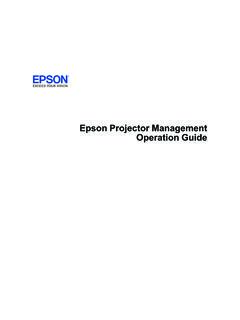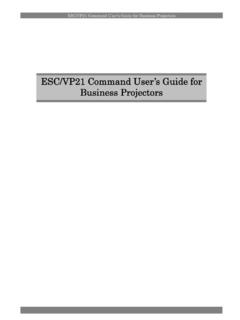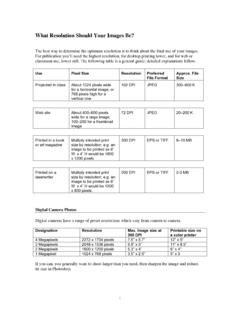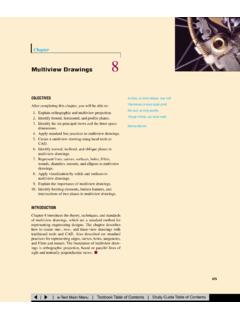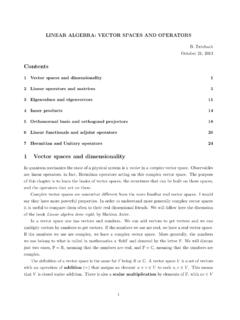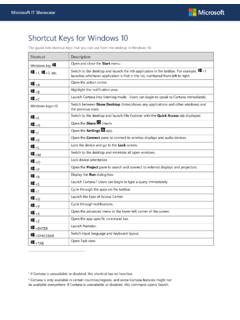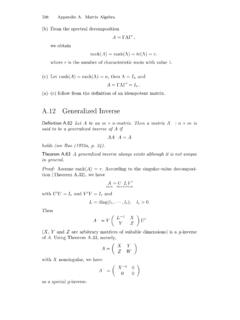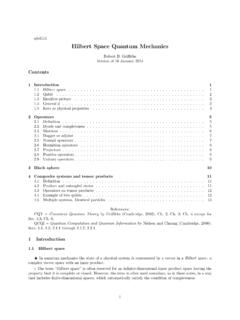Transcription of FLEXIBLE LEARNING AS NEW LEARNING DESIGN IN …
1 FLEXIBLE LEARNING AS NEW LEARNING DESIGN IN CLASSROOM PROCESS TO PROMOTE QUALITY EDUCATION ByAssistant Professor, Department, College of Education, Chenbagaramanputhoor, in the 21 century realize that students entering the classroom today are much different from those who have come before. Today's students are demanding a change in the classroom because of their ability to gather information faster than any other generation. It gives users on-demand access to the content, tools, training, information, and support they need to create and enhance LEARNING relevance and efficacy through both school-provided and personal technology. LEARNING is acquiring new, or modifying and reinforcing existing, knowledge, behaviours, skills, values, or preferences and may involve synthesizing different types of information. FLEXIBLE LEARNING is a set of educational philosophies and systems, concerned with providing learners with increased choice, convenience, and personalisation to suit the learner.
2 In particular, FLEXIBLE LEARNING provides learners with choices about where, when, and how LEARNING occurs. Sometimes it also referred to as personalized LEARNING . Quality determines how much and how well children learn and the extent to which their education translates into a range of personal, social and developmental benefits. The objective of this paper is to find whether FLEXIBLE LEARNING in classroom helps to promote quality education. Here the investigator used interview method to fulfil the study. The investigator prepared a FLEXIBLE LEARNING schedule to find the new LEARNING DESIGN in classroom process. The investigator collects the information from the student about the FLEXIBLE LEARNING DESIGN in classroom environment. The FLEXIBLE LEARNING moulds the learner to plan their activities according to their interest and enthusiasm. It also keeps the mind of learner in a pleasant situation that is out of external fear.
3 Finally the study concludes that FLEXIBLE LEARNING in classroom helps to promote quality : LEARNING , FLEXIBLE LEARNING , New LEARNING DESIGN , Classroom Processes, Quality ROBERT JOANINTRODUCTIONstEducators in the 21 century realize that students entering the classroom today are much different from those who have come before. Today's students are demanding a change in the classroom because of their ability to gather information faster than any other generation. To make authentic connections with students, we must change our strategies to fit this new age of students. With the resources available today for use in the classroom, such as interactive software, digital imaging, audio and video creation tools, on-demand video libraries, computers and LCD projectors , and Web tools, the hardest job may be choosing which tool to use and how to integrate it into the classroom.
4 It is the greatest time in history to be in a classroom because LEARNING technology is changing at an exponential rate, and our students can thrive with of this paperThis paper helps to find the importance of FLEXIBLE LEARNING . Now-a-days high percentage of students are benefiting from online LEARNING . Many students are joining in online course and it helps to use technology fully. It's a LEARNING environment that includes both wired and wireless access for students, teachers, and parents. It gives users on-demand access to the content, tools, training, information, and support they need to create and enhance LEARNING relevance and efficacy through both school and personal technology. The purpose of this study was to improve achievement for every student. and hence the present study was needed for this situation. FLEXIBLE learningAccording to Shurville et al.
5 (2008) FLEXIBLE LEARNING is a set of educational philosophies and systems, concerned with RESEARCH PAPERS37li-manager s Journal o , Vol. No. 1lnSchool Educational Technology 9 June - August 2013providing learners with increased choice, convenience, and personalisation to suit the learner. In particular, FLEXIBLE LEARNING provides learners with choices about where, when, and how LEARNING occurs . FLEXIBLE LEARNING approaches are often designed using a full range of teaching and LEARNING theories, philosophies and methods to provide students with opportunities to access information and expertise, contribute ideas and opinions, and correspond with other learners and mentors. This may occur through the use of internet-based tools such as Virtual LEARNING Environments or LEARNING Management Systems, discussion boards or chat rooms; and may be designed as a "blended" approach, with content available electronically and remotely, as well as "face-to-face" classroom tutorials and designA ' LEARNING DESIGN ' is defined as the description of the teaching- LEARNING process that takes place in a unit of LEARNING ( , a course, a lesson or any other designed LEARNING event).
6 The key principle in LEARNING DESIGN is that it represents the LEARNING activities and the support activities that are performed by different persons (learners, teachers) in the context of a unit of LEARNING designStudents must consider potential idiosyncrasies with various LEARNING devices ( , tablet, phone, PC), infrastructure requirements ( , cellular network, wi-fi, Bluetooth, online), and any special hypothetical circumstances if relevant. Also teach the student strategies for approaching and completing complex and novel tasks. Use the same strategy in different situations to make its use more automatic. The various LEARNING devices, different approaching and the novel tasks are the new LEARNING LEARNING EnvironmentsNew LEARNING environments are needed to support technology equipped students at work both individually and in collaborative teams, and to provide environments for what Roger Schank calls focused work, collaborative work, hands-on project work, and for presentation and exhibition (Fielding, 1999).
7 Classroom processesCarroll's model (1963) was the basis for a number of other attempts to identify and organize the primary variables associated with school LEARNING . Keeping the concept that educators should focus on variables under their control Squires, Huitt, & Segars (1981) proposed that both classroom- and school-level variables should be addressed. They adopted Carroll's student behaviour variable of "Perseverance" and relabelled it "Involvement." However, they added Coverage (the overlap of content taught to content tested) and Success (the rate at which students were successful on assigned academic tasks). Carroll's teacher behaviour variable of "Quality Instruction" was used as a subcategory within classroom processes and the subcategories of "Planning" and "Management" were added. While planning was not addressed by Carroll, management incorporates the variable "Opportunity" in that, one aspect of Management is to use all available classroom time for instruction (2006) took a different approach.
8 His QAIT model redefines Carroll's variables in terms of teacher behaviour, thereby focusing on the classroom teacher as the sole influence on school LEARNING . 'Q' stands for Quality of Instruction and is the same variable proposed by Carroll. 'A' stands for Appropriate Levels of Instruction and redefines the student characteristic variables of Aptitude and Ability to Understand Instruction as a teacher behaviour variable. These two variables are incorporated in the Instruction subcategory of the Squires et al. model. 'I' stands for Incentive and is a redefinition of the student behaviour variable of Perseverance into a teacher behaviour variable. 'T' stands for Time and is essentially equivalent to the Carroll variable of Opportunity. These two variables are incorporated in the Management subcategory in the Squires et al. educationAccording to the Education for all: Global Monitoring Report 2005 - The Quality Imperative (EFA: GMR), two principles characterise most attempts to define quality in education: the first identifies learners' cognitive development as the major explicit objective of all education systems.
9 The second emphasises education's RESEARCH PAPERS38li-manager s Journal o , Vol. No. 1lnSchool Educational Technology 9 June - August 2013role in promoting values and attitudes of responsible citizenship and in nurturing creative and emotional development." Quality determines how much and how well children learn and the extent to which their education translates into a range of personal, social and developmental benefits. It is the teaching and LEARNING process that brings the curriculum to life that determines what happens in the classroom and subsequently the quality of the LEARNING Definition for Key TermsFlexible LearningFlexible LEARNING refers to those who are interested in different way of LEARNING namely e- LEARNING , m- LEARNING and online LEARNING ( , FLEXIBLE LEARNING provides learners with choices about where, when, and how LEARNING occurs).
10 Other LearningOther LEARNING refers to those who are not interested in FLEXIBLE LiteratureWilson, Luanne, Boldeman, Ursula (2012) conducted a study on Exploring ICT Integration as a Tool to Engage Young People at a FLEXIBLE LEARNING Centre .The Edmund Rice Education Australia (EREA) FLEXIBLE LEARNING Centres aim to provide a supportive LEARNING environment for young people who find themselves outside of the mainstream secondary schooling system. Drawing on twenty first Century LEARNING principles, the Centres aim to deliver a personalised LEARNING experience with an emphasis on flexibility and individual choice. Provision of a comprehensive curriculum enables young people to make positive future life choices and successfully transition into employment and further training. The aim of this research project has been to work with teaching staff at a FLEXIBLE LEARNING Centre in North Queensland, Australia, to explore the value of integrating ICT in the form of Web technologies to enhance young people's engagement with the subject of science.










